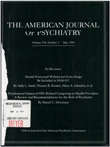Social competence and positive and negative symptoms: a longitudinal study of children and adolescents at risk for schizophrenia and affective disorder
Abstract
OBJECTIVE: The authors longitudinally examined social competence and positive and negative symptoms in children at risk for schizophrenia, children at risk for affective disorder, and matched normal subjects. METHOD: The subjects were offspring of parents with schizophrenia or affective disorder and normal comparison subjects matched on age, sex, and socioeconomic status. Ratings of social competence (Premorbid Adjustment Scale), affective flattening and poverty of speech (Scale for the Assessment of Negative Symptoms), and positive formal thought disorder (Scale for the Assessment of Positive Symptoms) were based on videotaped psychiatric interviews conducted in childhood (N = 144), early adolescence (N = 127), and adolescence (N = 106). RESULTS: In childhood, there were no significant group differences. In early adolescence, the subjects at risk for schizophrenia had poorer social competence than those at risk for affective disorder and the normal subjects. In early adolescence, the subjects at risk for schizophrenia also had greater positive thought disorder than those at risk for affective disorder but did not differ significantly from the normal subjects; there were no differences in negative symptoms. In adolescence, the subjects at risk for schizophrenia had poorer social competence and greater positive and negative symptoms than the adolescents at risk for affective disorder and the normal subjects. CONCLUSIONS: During early adolescence and adolescence, poor social competence may be more characteristic of children at risk for schizophrenia than those at risk for affective disorder. Higher levels of positive and negative symptoms may also be specific to subjects at risk for schizophrenia, but only during adolescence.
Access content
To read the fulltext, please use one of the options below to sign in or purchase access.- Personal login
- Institutional Login
- Sign in via OpenAthens
- Register for access
-
Please login/register if you wish to pair your device and check access availability.
Not a subscriber?
PsychiatryOnline subscription options offer access to the DSM-5 library, books, journals, CME, and patient resources. This all-in-one virtual library provides psychiatrists and mental health professionals with key resources for diagnosis, treatment, research, and professional development.
Need more help? PsychiatryOnline Customer Service may be reached by emailing [email protected] or by calling 800-368-5777 (in the U.S.) or 703-907-7322 (outside the U.S.).



